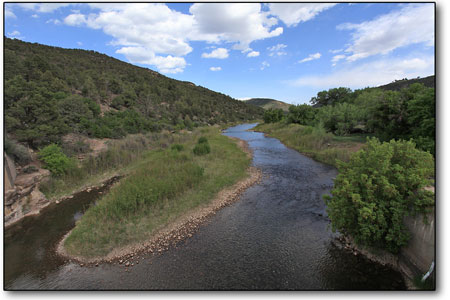 |
|
According to the Dolores River Boating Advocates, boatable releases on the lower Dolores River, which are based on the group’s recommended 1,000 cfs, have occurred only 19 times – or 63 percent of the time – in the past 30 years./Photo by Steve Eginoire |
Below the line
Snowpack not enough to keep lower Dolores River running for recreation
by Tracy Chamberlin
For the second year in a row, it’s just not enough. McPhee Reservoir near Dolores has enough water to meet its basic obligations, but not enough for those looking to enjoy whitewater boating in the lower Dolores River.
“There’s a lot of disappointed boaters,” said Lee-Ann Hill, program coordinator for the Dolores River Boating Advocates.
According to the group, boatable releases on the lower Dolores River, which are based on the group’s recommended 1,000 cubic feet per second, or cfs, have occurred only 19 times – or 63 percent of the time – in the past 30 years.
The boatable flow in, though, has been at that mark for all but two of the past 118 years. That’s 98 percent of the time. “It’s so far from the natural hydrograph,” Hill explained.
Mike Preston, general manager for the Dolores Water Conservancy District, said the main reason there isn’t enough for boating releases is continued water shortages.
Lowdown on the DoloresMay Meeting
What: Dolores River and McPhee Operations Meeting
When: Tues., May 6, 6:30 p.m.
Where: location to be determined
For info: doloresriverboating.org
River Festival
What: Dolores River Festival
When: Sat., June 7, 10 a.m. until dusk
Where: Joe Rowell Park in Dolores
For info: www.doloresriverfestival.com
|
Currently, the reservoir level is about 186,000 acre feet below live capacity and 52 feet below the average elevation, just above what the levels were last year at this time.
Preston explained that one tough year can be overcome when the reservoir is full. However, this season did not provide enough to make up for last year’s shortage. “We’ve used up the buffer,” he explained. “We’re living year to year.”
To get back to the point where boaters could see a release from McPhee, Preston said, they need one really great winter or a couple of good winters.
The current management plan for McPhee lays out guidelines for managing boating and fisheries but, according to American Whitewater Regional Director for the Southern Rockies Nathan Fey, there hasn’t been enough water in McPhee to put that plan into action.
One of American Whitewater’s goals is to conserve and restore whitewater resources across the Unite States. As one of the groups that Preston works with, they are aware of the situation at McPhee.
“We were pretty close this year,” Hill said.
But close isn’t enough. The waterline needs to hit a certain point for the plan to kick in, something that hasn’t happened since it was implemented about two years ago.
Even though boating releases are part of that plan, they don’t come with water rights. This means there are no guarantees. The boating community must wait and see if Mother Nature provides enough to go around. “We’re stuck in this pattern again this year,” Fey said.
The Dolores River Boating Advocates are looking for ways to manage McPhee and the Dolores, focusing efforts on optimizing flows, restoring the natural environment and protecting the river for whitewater boating.
But Hill said they also understand the need for consumptive uses like irrigation and agriculture. “The consumptive uses take priority,” she explained. “That’s not something we necessarily agree with; it’s just the way of the West.”
Fey and Hill mentioned a desire to work with other water users and find the most efficient way to manage the flow of the Dolores.
That discussion continues at a May 6 meeting. A panel featuring representatives from Colorado Parks and Wildlife, the Bureau of Reclamation and the Dolores Water Conservancy District will talk about the current management and operations of the Dolores River and McPhee Reservoir, as well as why there are no boating flows.
Like Durango, the areas around McPhee this winter saw little snow and plenty of dry ground in the lower elevations. Higher up, there was a decent snowfall. “The water that we’re going to get is going to be off that high snowpack,” Preston said.
It won’t be known exactly how bad or good the situation is until the spring runoff starts. At this point, though, it is better than it was a year ago.
The recent Snow Survey and Water Supply report from the Natural Resources Conservation Service shows reservoir storage in the San Miguel, Dolores, Animas and San Juan basins at 82 percent of average. The same time last year, it was only 66 percent of the average. Snowpack conditions, which directly affect the spring runoff, are also better at 111 percent of last year’s total.
“The effect of this is that spring and summer streamflow volumes are expected to be below normal across Southwestern Colorado this year,” the reports reads. “While there is still a possibility for spring snowstorms to improve conditions … the chances are extremely low given that the normal maximum snowpack is typically reached in the first week of April.”
Waiting for the lower Dolores isn’t the only option. Hill mentioned the San Juan, Chama and, of course, the upper Dolores, which doesn’t rely on releases.
Fey plans on enjoying the upper Dolores this year. “That whole stretch … is just a fantastic resource.”
He described the Dolores as a unique river system, adding that the real driver is the upper section. The upper Dolores will be boatable this season, according to Hill. It starts flowing in May, but with earlier runoffs, the time to start watching the flows is now. “It’s time to start watching those hydrographs,” Hill said.
